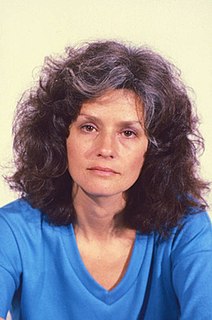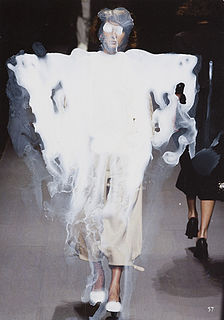Related Research Articles

Judy Chicago is an American feminist artist, art educator, and writer known for her large collaborative art installation pieces about birth and creation images, which examine the role of women in history and culture. During the 1970s, Chicago founded the first feminist art program in the United States at California State University Fresno and acted as a catalyst for feminist art and art education. Her inclusion in hundreds of publications in various areas of the world showcases her influence in the worldwide art community. Additionally, many of her books have been published in other countries, making her work more accessible to international readers. Chicago's work incorporates a variety of artistic skills, such as needlework, counterbalanced with skills such as welding and pyrotechnics. Chicago's most well known work is "The Dinner Party", which is permanently installed in the Elizabeth A. Sackler Center for Feminist Art at the Brooklyn Museum. "The Dinner Party" celebrates the accomplishments of women throughout history and is widely regarded as the first epic feminist artwork. Other notable art projects by Chicago include International Honor Quilt, The Birth Project, Powerplay, and The Holocaust Project. She is represented by Jessica Silverman gallery and Salon 94 gallery.

Womanhouse was a feminist art installation and performance space organized by Judy Chicago and Miriam Schapiro, co-founders of the California Institute of the Arts (CalArts) Feminist Art Program and was the first public exhibition of Art centered upon female empowerment. Chicago, Schapiro, their students, and women artists from the local community, including Faith Wilding, participated. Chicago and Schapiro encouraged their students to use consciousness-raising techniques to generate the content of the exhibition. Together, the students and professors worked to build an environment where women's conventional social roles could be shown, exaggerated, and subverted.
The Woman's Building was a non-profit arts and education center located in Los Angeles, California. The Woman's Building focused on feminist art and served as a venue for the women's movement and was spearheaded by artist Judy Chicago, graphic designer Sheila Levrant de Bretteville and art historian Arlene Raven. The center was open from 1973 until 1991. During its existence, the Los Angeles Times called the Woman's Building a "feminist mecca."
Sheila Levrant de Bretteville is an American graphic designer, artist and educator whose work reflects her belief in the importance of feminist principles and user participation in graphic design. In 1990 she became the director of the Yale University Graduate Program in Graphic Design and the first woman to receive tenure at the Yale University School of Art. In 2010 she was named the Caroline M. Street Professor of Graphic Design.
Faith Wilding is a Paraguayan American multidisciplinary artist - which includes but is not limited to: watercolor, performance art, writing, crocheting, knitting, weaving, and digital art. She is also an author, educator, and activist widely known for her contribution to the progressive development of feminist art. She also fights for ecofeminism, genetics, cyberfeminism, and reproductive rights. Wilding is Professor Emerita of performance art at the School of the Art Institute of Chicago.

Arlene Raven was a feminist art historian, author, critic, educator, and curator. Raven was a co-founder of numerous feminist art organizations in Los Angeles in the 1970s.

June Claire Wayne was an American painter, printmaker, tapestry innovator, educator, and activist. She founded Tamarind Lithography Workshop (1960–1970), a then California-based nonprofit print shop dedicated to lithography.

The feminist art movement in the United States began in the early 1970s and sought to promote the study, creation, understanding and promotion of women's art. First-generation feminist artists include Judy Chicago, Miriam Schapiro, Suzanne Lacy, Judith Bernstein, Sheila de Bretteville, Mary Beth Edelson, Carolee Schneeman, Rachel Rosenthal, and many other women. They were part of the Feminist art movement in the United States in the early 1970s to develop feminist writing and art. The movement spread quickly through museum protests in both New York and Los Angeles, via an early network called W.E.B. that disseminated news of feminist art activities from 1971 to 1973 in a nationally circulated newsletter, and at conferences such as the West Coast Women's Artists Conference held at California Institute of the Arts and the Conference of Women in the Visual Arts, at the Corcoran School of Art in Washington, D.C..
Vanalyne Green is an American artist who also teaches and writes about culture. She has screened her video work extensively in the United States and abroad, including The Whitney Biennial (1991), American Film Institute, Rotterdam International Film Festival, the Videotheque de Paris, The Robert Flaherty Film Seminar, The Guggenheim Museum and many other museums, universities and film festivals. She has received a Guggenheim Foundation fellowship, as well as grants from Creative Capital, the Jerome Foundation, the Richard H. Driehaus Foundation (2003), the National Endowment for the Arts, the New York State Council of the Arts, and a Rome Prize at the American Academy in Rome (2001–2002). Her work has been covered in the Village Voice, the Los Angeles Weekly, The Chicago Reader, and Artforum. Publications by and about, and interviews with, Green also can be found in "Performance Artists Talking in the Eighties" by Linda M. Montano, "Women of Vision" by Alexandra Juhasz, in addition to M/E/A/N/I/N/G: An Anthology of Artists' Writings, Theory, and Criticism. Green's videotape "A Spy in the House that Ruth Built" was listed as one of the 1,000 best films ever made by film critic and author Jonathan Rosenbaum.

Feminist art is a category of art associated with the late 1960s and 1970s feminist movement. Feminist art highlights the societal and political differences women experience within their lives. The hopeful gain from this form of art is to bring a positive and understanding change to the world, in hope to lead to equality or liberation. Media used range from traditional art forms such as painting to more unorthodox methods such as performance art, conceptual art, body art, craftivism, video, film, and fiber art. Feminist art has served as an innovative driving force towards expanding the definition of art through the incorporation of new media and a new perspective.

Miriam Schapiro was a Canadian-born artist based in the United States. She was a painter, sculptor, printmaker, and a pioneer of feminist art. She was also considered a leader of the Pattern and Decoration art movement. Schapiro's artwork blurs the line between fine art and craft. She incorporated craft elements into her paintings due to their association with women and femininity. Schapiro's work touches on the issue of feminism and art: especially in the aspect of feminism in relation to abstract art. Schapiro honed in her domesticated craft work and was able to create work that stood amongst the rest of the high art. These works represent Schapiro's identity as an artist working in the center of contemporary abstraction and simultaneously as a feminist being challenged to represent women's "consciousness" through imagery. She often used icons that are associated with women, such as hearts, floral decorations, geometric patterns, and the color pink. In the 1970s she made the hand fan, a typically small woman's object, heroic by painting it six feet by twelve feet. "The fan-shaped canvas, a powerful icon, gave Schapiro the opportunity to experiment … Out of this emerged a surface of textured coloristic complexity and opulence that formed the basis of her new personal style. The kimono, fans, houses, and hearts were the form into which she repeatedly poured her feelings and desires, her anxieties, and hopes".
Carol Heifetz Neiman was an American artist who was a member of the feminist art movement of the 1970s, known for her surrealist and xerox art. She also created etchings, and worked in pencil, pastels, and mixed media and was a painter.
Joyce Aiken is an American feminist art historian, artist, and educator. Aiken taught the subject for over 20 years at California State University, Fresno, and assisted her students in opening a feminist art gallery. This helped put Fresno, California on the map as a key place for the feminist art movement. Most recently, she served as the director of the Fresno Arts Council.
The Women's Caucus for Art (WCA), founded in 1972, is a non-profit organization based in New York City, which supports women artists, art historians, students, educators, and museum professionals. The WCA holds exhibitions and conferences to promote women artists and their works and recognizes the talents of artists through their annual Lifetime Achievement Award. Since 1975 it has been a United Nations-affiliated non-governmental organization (NGO), which has broadened its influence beyond the United States. Within the WCA are several special interest causes including the Women of Color caucus, Eco-Art Caucus, Jewish Women Artist Network, International Caucus and the Young Women's Caucus. The founding of the WCA is seen as a "great stride" in the feminist art movement.
Nancy Youdelman is a mixed media sculptor who lives and works in Clovis, California. She also taught art at California State University, Fresno from 1999 until her retirement in 2013. "Since the early 1970s Youdelman has been transforming clothing into sculpture, combining women's and girl's dresses, hats, gloves, shoes, and undergarments with a variety of organic materials and common household objects.
Karen LeCocq is an American artist. She is a nationally-known sculptor whose work combines organic materials and found objects.

The Fresno Art Museum is an art museum in Fresno, California. The museum's collection includes contemporary art, modern art, Mexican and Mexican-American art, and Pre-Columbian sculpture.
Jan Oxenberg (1950) is an American film producer, director, editor, and screenwriter. She is known for her work in lesbian feminist films and in television.
Sherry Brody was an American artist and pioneering member of the feminist art movement. Brody is known for her work on the Womanhouse project. Her sculpture, The Dollhouse, is in the Smithsonian Museum of American Art collection.
References
- 1 2 Harper, Paula (1985). "The First Feminist Art Program: A View from the 1980s". Signs . 10 (4): 762–81. JSTOR 3174313.
- 1 2 3 Dr. Laura Meyer; Nancy Youdelman. "A Studio of Their Own: The Legacy of the Fresno Feminist Art Experiment". A Studio of their Own. Retrieved 8 January 2011.
- ↑ Fields, Jill (2012). Entering the Picture: Judy Chicago, The Feminist Art Program and the Collective Visions of Women Artists. New York, NY: Routledge. pp. 37–41. ISBN 0415887690.
- ↑ Meyer, Laura (2003). "The Los Angeles Woman's Building and the Feminist Art Community, 1973–1991". In James, David E. (ed.). Sons And Daughters Of Los: Culture And Community In L.A. Temple University Press. pp. 39–62. ISBN 978-1-59213-012-2.
- ↑ Sorkin, Jenni (2011). "Learning From Los Angeles: Pedagogical Predecessors at the Woman's Building". Doin' It in Public: Feminism and Art at the Woman's Building. Otis College of Art and Design. pp. 36–65. ISBN 0930209222.